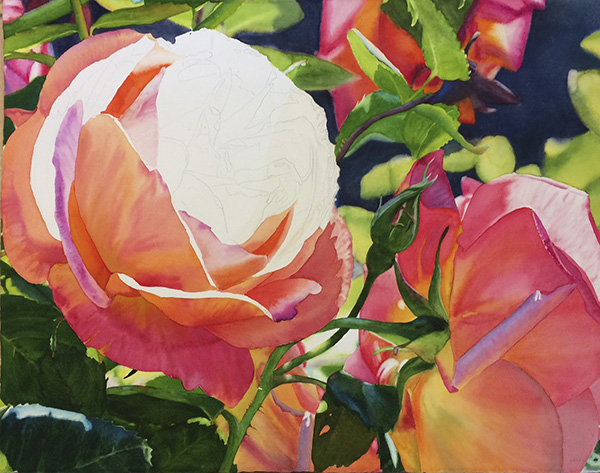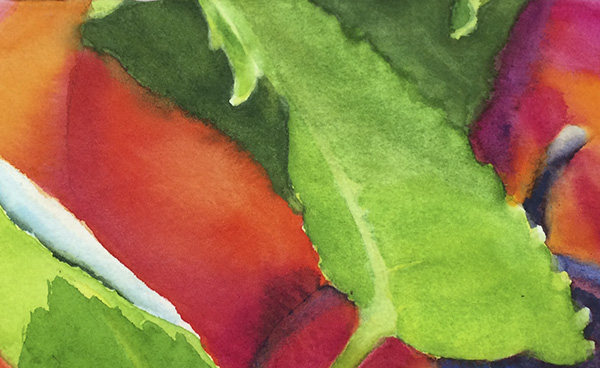March 15, 2016 – Sorta Perfect
- At March 15, 2016
- By Cara
- In Life Stories
 0
0

My sorta perfect, getting there painting
Listen to this post:
Last week Paulette, one of our Thursday faithfuls, forwarded to me an email with a plea for my help in responding to it. She’d been offered an opportunity to do a demonstration for a watercolor organization. First, I must say how wonderful and gratifying it is for me, to have artists in our groups garner responses like this for their work. I am a proud mama-leader to have artists of such caliber in my world. But, there was an “ee-gads” in Paulette’s response, which I completely understand and want to explore today. You see, I’ve been asked a few times over the years by various watercolor groups, to do demonstrations too. I’ve had that same “ee-gads” response and have always begged off.
My fear is that in a short painting demonstration, people – likely other artists who are hungry to learn – want to see magic. They want to see me paint a few brush strokes and “voila! It’s a flower!” But that’s not the way it works for some of us – Paulette and me included. When you look at our finished work, there is indeed something to it. The paintings live as if they are real. And they often trigger a desire in other – less experienced – artists to want to know how to paint like this. For starters, there’s a lot more to how we paint than technique. The images we choose to paint, have striking light and we hope a compelling – or at least interesting – composition. For me, I have to sense there’s something there in the image, for me to spend all the time I do painting it. But the painting part is mostly quite a struggle. Paulette and I tease that we have to “torture” our work into being.

My sorta perfect “mess” of a leaf (on the right) in the process of being re-worked
Just yesterday, working on this rose painting, there was a leaf that had gotten too dark and the shadow on it had a hard edge that was really distracting. I tried to fix it which made it worse. So I lifted the whole thing and started over. I’ve painted the yellow green of the leaf – not as light and transparent as I’d wanted, but it’ll do. I’ve yet to paint the shadow back in – so now if you look at it closely, to my eye, it still looks like quite a mess. This is not the work and process that I think people are expecting to see in a demonstration. And yet, I wonder if it isn’t exactly what I should be demonstrating. As much as mastery is thrilling to behold, we come by it in a mundane, down-in-the-trenches way. This seems to me to be a much more helpful, and even hopeful message than “voila, it’s a flower.”
I receive email letters twice a week from “The Painter’s Keys.” On Tuesday, comes one from the late Robert Genn – from his archive of posts before he died. His daughter, Sara, also an artist, sends a letter on Fridays. Her message from last week touched me and – along with Paulette – inspired what I’m sharing with you today. She starts here:
Carefully curated images on social media of shiny children and food, vacations and relationships presented by normal breathing humans, are irking social scientists. Apparently, the suffocating display of a polished facsimile of human experience without evidence of the associated toil, rather than delivering the desired feeling of connection and love, is alienating us and giving us the blues.
She goes on about the impact of struggle and toil in our art work. I found myself saying, “here, here.” Though there is a part of us that longs to be able to breeze easily through our paintings, it’s mostly not how it goes. For some time now, I’ve held that the struggle that it takes actually gives our work more of something – more of us, more of our humanity – and thereby imbues the art with another kind of magic that’s hard to put a finger on.
I did an art festival in a big building in Fort Mason on a rainy weekend in November 2007, my first year showing my work. It was a bust. At any given time, the number of exhibiters far exceeded the number of festival goers. The show cost me $600, plus an investment in overhead lights and all my time and effort. All weekend I sold only $40. Because there were so few people there, we spent a lot of time meeting other artists and their work. A lovely woman, a jeweler, came to visit my booth and in looking at my paintings – Paris Roses and Twin Dahlias were there – she said “oh, you are going to be famous – there is a real emotional quality in your work.” At the time I found what she said incredulous, but I’ve never forgotten it. I’m not sure about the famous part, but that she saw or felt emotion in my work, was the first clue for me that we are in our work. I believe that much of this comes through our struggling.
There is another piece coming to me now – tenacity and faithfulness to our vision, both play a big part. For whatever reason, ever since I started taking watercolor painting seriously, about 15 years ago, I’ve made myself finish every painting. By doing so, I’ve learned a ton. If something wasn’t working out, didn’t please me, I’d try to figure out how and why, and then do what I could to bring it closer to my vision. It’s not always completely successful. There are parts of paintings – paintings I’ve sold and that are quite beloved by some of you – that I still cringe if I look closely at them. The overall is fine, but those parts…! Nevertheless, by sticking with it, I’ve kept lots of paintings from being tucked away in a stack in the studio.
I see this at play in our groups. An artist will show me a painting they’ve worked really hard on. Either they are really ready to be “done” – or they wonder if they should just give up on it. I or someone else in the group almost always sees something that we’d do – if it were our painting – that will take it further along. One of the best parts of doing what I do, is seeing the appreciation – and wonder, even – in an artist who is pleased with the work they were ready to abandon.
The seeking of perfection is a funny thing. It’s a force that pulls us along, but it’s also a way we can punish ourselves and reject our work. I wish I could remember the exact situation, but recently I found myself saying the phrase “sorta perfect.” It was in response to something that happened that was unexpected and undesired, but which ended up with a result that was actually better in the end. As I said it, I was struck by its paradox. Perfect – as we usually think of it – isn’t a part-way thing. Perfect is perfect.
Today, in looking at all of this, I’m embracing “sorta perfect” as the best kind of perfection – a more sophisticated way to say it is “wabi-sabi.” But I like “sorta perfect.” Sorta perfect is life, it’s human. It speaks to our vulnerability, as well as carries an appreciation for us and what we do. I want for us all to remember that in any given moment, we are all doing the best we can, with our current skills and abilities. Here’s to our sorta perfection!
Love,
Cara





